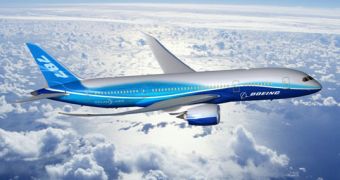Boeing's 787 Dreamliner has just landed in the UK, as part of its international tour to introduce itself to companies looking to offer their clients safer, more comfortable and greener flights. It won't go into circulation until next year.
Initially scheduled to start flying some years ago, the Dreamliner has undergone considerable change since first projected.
As The Telegraph points out, they make it perfect for long-distance flights because it's more comfortable, definitely better looking, more energy-efficient and overall more protective of the environment.
For the time being, though, only 13 such aircrafts are in use and all of them from Japanese companies.
British travelers will be able to fly out of their home country on a Dreamliner no sooner than summer 2013, with some companies taking as long as 2014 to introduce it.
“The interest in such a futuristic aircraft of a company such as Thomson, which specializes in the conventional package holiday market, lies not just in the emphasis on greater passenger comfort but in the greater fuel efficiency,” The Telegraph reports, speaking of one airline company that will be using the Dreamliner.
“The 787 uses about 20 per cent less fuel, costs 30 per cent less to maintain, and has a noise footprint 60 per cent smaller than aircraft of the same size,” adds the same media outlet.
In other words, it's very eco-friendly: the most eco-friendly aircraft of the type to date.
There is also the plus of comfort to consider: the Dreamliner has adjustable wings, larger windows and is made from a material that isolates outside noise better, making the flight a more enjoyable experience.
“Unlike the traditional aluminium fuselage, the 787’s eye-catching body is made from a composite mixture of carbon and polymer resin,” the British publication writes.
“These plastic composites enable the aircraft to maintain a higher cabin pressure, recreating the conditions of an altitude of 6,000ft, rather than the more typical 8,000 ft, meaning passengers should experience fewer symptoms of jetlag, such as headaches, dizziness and dehydration,” adds The Telegraph.
That is to say, flying with such an aircraft is a win-win situation, both for the traveler and the environment.

 14 DAY TRIAL //
14 DAY TRIAL //